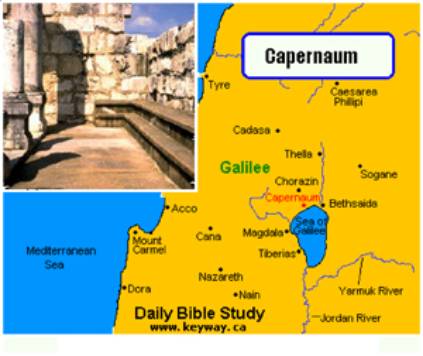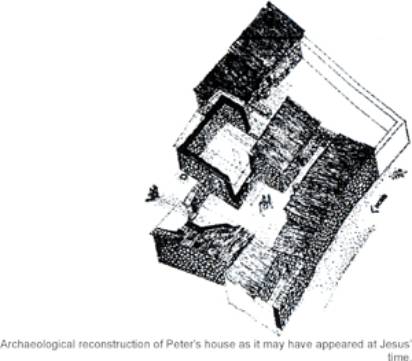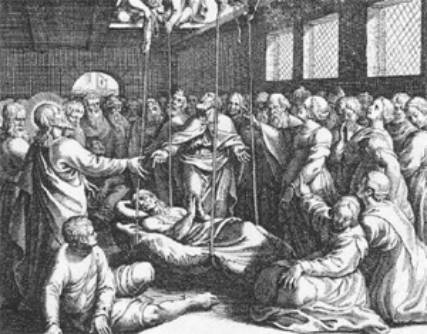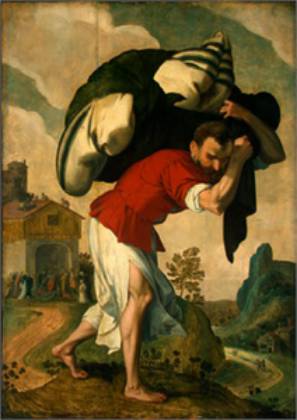
Christmas
Easter
Pentcoest
All Saints
Christ The King
Confirmation
Palm/Passion
Reformation
Stewardship
Books of the Bible
Lenten Series
Christmas Dramas
Videos
Series A - Matthew
Series B - Mark
Series C - Luke
Series D - Other
To contact
Edward F. Markquart
info@sfs.com
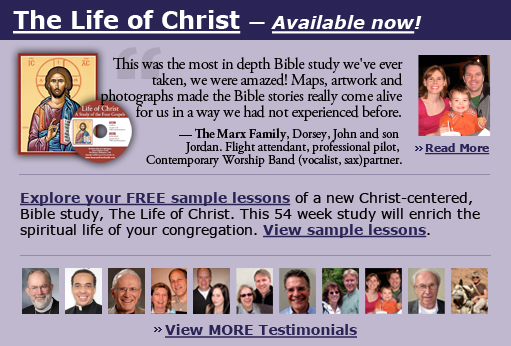
Series B Epiphany 7B Mark 2:1-12 (Create a power point of the pictures in this sermon.) The gospel story for today is another one of those all time, great, “classic” stories about Jesus. Today’s gospel story is so graphic, so visual, so etched into our minds. If you grew up and attended Sunday School as a child, you heard this story over and over again. I did. In Sunday School years ago, we would color a picture of the four men on the roof of Jesus’ home, cutting a hole in that roof, and letting their paralyzed friend down through a hole in that roof to see Jesus. Jesus then healed the crippled man. These four friends couldn’t get to Jesus through the front door because of the crowds of people inside and outside the house, so these four friends had to be imaginative and persistent. They cut a hole in the roof of Jesus’ house and let their friend down on a mat through the hole in the roof. Their paralyzed buddy landed right in front of Jesus. Yes, I still can remember coloring that picture from years ago during Sunday School. The gospel story for today is so graphic, so visual, so etched in our minds. Please pull out your bulletin insert and let us closely examine the gospel lesson for today. It is a classic story and it is fun to study in detail. -When he returned to Capernaum after some days, it was reported that he was at home. Circle the words, “Capernaum,” “after some days,” and the words, “at home.” To begin this sermon, let’s focus on these three sets of words. The story for today occurs in Capernaum. Capernaum was Jesus’ hometown during his adult years. Let’s momentarily immerse ourselves in Capernaum where Jesus lived and had a house. Did you know that Jesus had a house? I bet you didn’t. Find Capernaum on the map below. You can find the city of Capernaum on the north end of the Sea of Galilee. The name of the city is listed in red. http://www.execulink.com/~wblank/20020117.htm
Did you know that Capernaum was Jesus’ hometown? That both the gospels of Matthew and Luke refer to Capernaum as Jesus’ own city? Did you know that you can’t find the city of Capernaum in the Old Testament? Why? This city didn’t exist then. Archeologists tell us the city of Capernaum developed about two hundred years before Jesus. Did you know that? Did you know that Capernaum was at a cross roads of international commerce and was a prosperous town? (So archeologists tell us.) Did you know that there were about a thousand residents living in Capernaum during New Testament times? (So archeologists tell us.) Did you know that the houses in Capernaum were well constructed with dress stones and plastered walls and reveal a prosperous culture at that time in history? (So archeologists tell us) http://www.christiananswers.net/bibleplaces/home.html The picture below is a fantastic photograph and needs to be memorized in your mind in order to remember many of the most important geographic locations in Jesus’ life.
Find and focus on the location of Tabgha, the location of the feeding of the 5000. Find the Mount of Beatitudes where Jesus gave his Sermon on the Mount. Find Capernaum, Jesus’ own city where he had his own home. Find Bethsaida, where Simon Peter was from. Find the seashore from Tabhha to Capernaum. This was the scene of Jesus walking on the water. You can see from the photograph, that Capernaum was a “city on the sea.” Did you know that Capernaum had rich and fertile lands around it and had plantations of a great variety of trees? The ancient historian Josephus was one of the best, most reliable historians writing at that time of history. Josephus tells us that at Capernaum were rich and fruitful lands and plantations of a variety of trees. Let’s spend a few moments talking about houses in Capernaum. According to our text for today, Jesus had a house there in that village. In the story for today, four friends dug through the roof of Jesus’ house and lowered their friend on at mat into the house. Remember the word, “dug.” The friends DUG a hole through the roof. Did you know that houses in Capernaum had three rooms and two courtyards? That one room was for sleeping; another room was for cooking; and the third room was for animals? (So archeologists tell us.) Did you know that houses in Capernaum and other parts of that ancient world had hardened mud roofs? That saplings were put across the top of the home, that briars were put between the saplings, and that mud was pressed into the briars so it could dry? Did you know that homes often had mud roofs? Did you also know that we find similar mud bricks and mud roofs in very poor homes in poor fourth world countries? The following is a diagram of the reconstruction of Peter’s house. Peter’s house was most likely similar to Jesus’ house in the same city. http://www.christiananswers.net/dictionary/capernaum.html
In those days, there was a stairway to the flat roof. People used to climb the stairs to the flat roof that covered the top of the house. On the flat roof of the house, in my mind, people would come at night to enjoy the cool of the evening, talk to one another, see the stars and enjoy the sounds of the city of Capernaum. The roof of a house was made out of wooden beams with saplings strung across them. The roof itself was filled with tight briar branches. Then the home builders would use clay and put clay on those tightly woven briar branches. The clay would dry and the roof would become a hard-baked clay roof. Such was Jesus’ little house in that city of Capernaum by the sea. Let’s go to the next verse in your bulletin. -So many gathered around that there was no longer room for them, not even in front of the door; and he was speaking the word to them. We can easily visualize a crowded room. Luke’s version of this story tells us that people had come from every village of Galilee and Judea and even from Jerusalem. Why was Jesus’ house so full of people? Jesus was at the beginning of his public ministry. For the past few days, Jesus had been out preaching, teaching, and healing around the city of Capernaum. In the Gospel of Mark, chapters 1-3, Jesus was out preaching, teaching and healing. There were ten consecutive healing miracles at the beginning of Marks’ gospel. The healing of the paralytic was the fifth in this series of healings. So, in my mind and imagination, Jesus came home exhausted one night after preaching, teaching and healing for a few days. Jesus was tired. He came home for a rest that night. He was going to close the door, but people wouldn’t let him. Pretty soon his house with jammed full of many of the townspeople from Capernaum who had heard him preach, teach and seen him heal. His house was jammed packed, with people inside the house and people outside the house. People were all over the place. -Then some people came, bringing to him a paralyzed man, These four friends had probably seen Jesus heal other people that same day and they thought that perhaps Jesus could heal their paralyzed friend as well. Why was the man paralyzed? People just assumed it was because of some sin he did or his parents did. How long was he paralyzed? We don’t know the severity of his paralysis. The Bible doesn’t say that he was paralyzed for 38 years like the story of the paralytic in the Gospel of John. We know he was sick and paralyzed. -carried by four of them. There were four friends who were carrying their paralyzed buddy. We like these four friends. They were helping their buddy who was sick. These four friends become of model of compassionate people who care for their friends when they are sick and in need of help. -And when they could not bring him to Jesus because of the crowd, they removed the roof above him; These four friends were ingenious and persistent. They were going to find a way to get their sick buddy in front of Jesus the healer. They didn’t let a crowd stop them. The four men carried the stretcher up to the home of Jesus but they couldn’t get to the front door, let alone get into the house itself because of the crowds. They thought to themselves, “What are we going to do?” Bingo. A light went on. “Let’s take our friend up to the roof, to the roof of the house, dig a hole, and drop our friend through the hole, still on the mat, down to Jesus. What a plan. It will work.” And away the friends went. -and after having dug through it, they let down the mat on which the paralytic lay. Underline the phrase, “dug through the roof.” We can imagine these four friends digging through a mud roof. In our mind, we usually think of wooden roofs that need to be cut through with saws, but here was a roof composed of mud and it needed to be dug through. The four friends took their paralyzed friend up the stairways to the roof, took their knives and dug a hole in that dry clay roof. They dropped their friend right down into the living room, right into the presence of Jesus. The four friends let their paralyzed friend down as he lay on a mat. We can easily visualize them doing it. So have artists through the centuries. http://home.halden.net/rolf/merian/m154.jpg Matthaeus Merian the Elder, 1625-30.
What do you see in the picture? The sick man facing Jesus. Jesus with his right hand outstretched. People crowded in a hall. The crowds looking up. Friends up above who lowered the sick man down. Four ropes. Windows with iron grates. Western women wearing gowns from seventeenth century Europe. A hall that looks like it is hall from seventeenth century Europe rather than a three room home from ancient Israel with two courtyards and a mud roof. We recall that such paintings were pre-archeology. That is, this is what the painter saw in his imagination at his time in history. The painting is great and captures the essence of the situation. -When Jesus saw their faith, Circle the words, “their faith.” This is one of the many stories where Jesus emphasized the power of faith. It wasn’t just the healed man who had faith but so did his four friends. When Jesus saw THEIR faith. Friends are important to our faith. It was not only the paralyzed man who believed but his four friends also believed. The four friends had faith. Jesus saw their faith. Often our friends encourage and enlarge the faith that we have. (That is what the story of Daniel is about, the four friends who helped each other be loyal to their faith and religious practices.) Friends are friends when we are sick. Friends are present to help us when we are sick, and these particular friends proved to be very good supporters. -He said to the paralytic, "Son, your sins are forgiven." Now, that may seem an odd thing for Jesus to say, but not for his audience. The Jews of that day believe that sin was the cause of illness and that sin caused their friend’s paralysis. Illnesses such as blindness and paralysis were thought to be the direct consequence of sin. So Jesus said to the paralyzed man, “Your sins are forgiven” as a means a beginning the healing process. Listen to Jesus and his other similar words about forgiveness during other healings. To the woman at the well, Jesus said, “My daughter, your sins are forgiven.” To Peter’s mother-in-law when he healed her, “Woman, your sins are forgiven.” To the centurion’s servant, “My son, your sins are forgiven.” This line is the key to the story. Jesus has the power to forgive sins, and when sins are forgiven, there is healing in one’s life. This was true centuries ago and is often true today. That is, a particular sin or sins can work deeply in the psyche so much as to create physical paralysis. I personally have seen people literally paralyzed by guilt and sin. Perhaps you have seen such a person as well. Perhaps you are that person. Perhaps your life has been paralyzed by guilt, perfectionism, bad habits and you are paralyzed and unable to do what is right. In this situation, we need to be freed of our paralysis and often forgiveness is very important in order to become healthy again. -Now some of the scribes were sitting there, questioning in their hearts, "Why does this fellow speak in this way? Circle the words, “scribes” and underline the phrase, “questioning in their hearts.” In the first three gospels, the “enemy” of Christ was almost always the scribes and the Pharisees, who were the leaders of the Jewish establishment. The scribes were the ones who had their advanced degrees in knowledge of the Biblical laws of the Torah, the first five books of the Old Testament. They and the Pharisees were partners in thought and attitude: they were the strict interpreters of the Old Testament Law for their daily lives. They thought that other people should live according to their strict interpretations of the Old Testament Torah. We have seen the equivalent to the scribes and Pharisees in every religion and every century. They are those hyper-educated religious leaders who often love their religion more than the mercy of God. They love their interpretations of their Bible more than the love God. They love their own religious book and their own religion more than the sick people in front of them. These educated religious leaders (call scribes in this text) are found in all religions, in Judaism, Christianity and Islam, in Buddhism, Hinduism, and Shintoism. Again and again through out history, we find the equivalent of scribes and Pharisees, those religious zealots who love their religious interpretations, their form of their religion, their religious book more than the love and mercy of God. And more than the sick man right under their noses. Their zeal is not for God’s mercy but for their religion. What was the reaction of all those religious priests, pastors and philosophers and those other zealous religious hotshots who were there in the middle of the room? Were they glad to see the paralyzed man healed? Were they delighted to see a miracle of God? Were they happy to see a man restored to health? NO. Heavens no. They were a bunch of religious sour pusses. Instead these Pharisees shouted, “Blasphemy. Only God can forgive sins. Who do you think you are Jesus, that you have the power to forgive sins?” Jesus knew what was going on in the hearts of these religious sour pusses. These religious sour pusses had stoney faces and stoney hearts. These scribes had no love for God. These scribes had no love for people who were hurting. These scribes had no love for their neighbors. The only people they ever loved were religious stuffed shirts like themselves who were part of their religion and their interpretation of what they perceived to be the truth. -It is blasphemy! Who can forgive sins but God alone?" Circle the word, “blasphemy.” Blasphemy is the ultimate charge that was leveled at Jesus. Blasphemy was making one’s self equivalent to God. Human beings are not to elevate themselves to divinity. The scribes knew their Bible and knew it well. They had their PH. D. in Bible study and they knew well Leviticus 24:16. These Biblical scholars knew that blasphemy was to be punished by stoning. The scribes knew their Old Testament law: ONLY GOD COULD FORGIVE SINS. NOBODY ELSE. Their comments lay the groundwork for what Jesus meant when he said that he could forgive sins. -At once Jesus perceived in his spirit that they were discussing these questions among themselves; and he said to them, "Why do you raise such questions in your hearts? Which is easier, to say to the paralytic, "Your sins are forgiven,' or to say, "Stand up and take your mat and walk'? Jesus put the scribes and Pharisees on the defensive. Jesus, as always, put "the squeeze" on the doubters and trapped them in their own confessions. The Pharisees tried to trap Jesus again and again. In response, again and again, Jesus asked the Pharisees a razor sharp question that they could not answer. Jesus was forever trapping the Pharisees with his penetrating questions and analyses. -But so that you may know that the Son of Man has authority on earth to forgive sins" Circle the words, “Son of Man.” Focus on that title. In this passage, Jesus identified himself as the Son of Man who not only comes at the end of history to be the final judge, but also has the power to forgive sins. In the Old Testament, only God had the authority to forgive sins. Now, Jesus was assuming that authority of forgiveness, making himself equal with God. In the New Testament, did Jesus ever identify himself as the Son of God? No. Did he identify himself as the Jewish Messiah? No. One time, Matthew, a Jewish gospel. Did Jesus identify himself as the Son of Man? Yes, repeatedly. Often. Son of Man was Jesus’ self-designation. We will slowly discover that the primary title that Jesus applied to himself was "Son of man." Jesus was saying about himself that he has the power to forgive sins. The Jewish scholars knew that only the Lord God had the power to forgive sins. Jesus was saying as bluntly as possible he had the same power to forgive sins that God did. -He said to the paralytic— "I say to you, stand up, take your mat and go to your home." What great news. What healing. We like that: Jesus inviting people to stand up. And go home. We are also keenly aware that Jesus spoke this particular word to this particular man. It isn't that Jesus said to all sick people to get out of bed and be healed. Real life does not work that way. -And he stood up, and immediately took the mat and went out before all of them; so that they were all amazed and glorified God, saying, "We have never seen anything like this!" That is the way the people reacted to the healing miracle that happened to them and is also the way we also respond when we experience God’s miraculous healing in our lives. Of course, it is not inevitable that a healed person will praise God and share the good news of God’s healing. We will study the story of the ten lepers who were healed and only one came back to thank Jesus for the healing that was given to all ten of them. But there is power to the testimony of God’s healing in one’s own life. http://www.nga.gov/cgi-bin/pimage?12210+0+0
Netherlands, 16th Century What do you see in this painting? A man carrying his bedding. His strong legs. His strong arms. A tall building in the background to the left with people on the roof, implying that they were the ones who cut the hole in the room. Most of all, we see a man who had been healed by Jesus. When we see a person that we know was healed by the power and presence of God, we rejoice immensely. We see the man up and walking and we know that God wants to make us stand up and walk as well. What does this story mean for us today? There are four sets of characters in the story: the four friends, the one man who was paralyzed, Jesus himself, and the religious scribes. Let’s briefly focus on each of them, and see what we can learn from them. First, the four friends. Throughout the centuries, people have been attracted to these four helpful friends. When we are sick, don’t we want to have good friends who are willing to help? To come and visit us? Get us to the doctor? Telephone us? Don’t we appreciate good friends who really help us and our family when someone is sick in our family? Some people “talk the talk” of compassion and other “walk the walk” of compassion and truly are helpful when someone in our family is sick. We count on those friends to help. These four friends were helpers, were doers, were action folks who got the job done. These four friends who carried their paralyzed friend on a stretcher were really persistent and imaginative to get their “friend in need” right in front of Jesus. We like that. We like these four men and their persistence, their perseverance, their doggedness, their imaginative spirit. They knew that they needed to get their paralyzed friend into the healing presence of Jesus, and they did it. Sometimes, we are in a similar situation where we have a friend who needs the healing presence of Jesus. Most often, it is we ourselves who need the healing power of Jesus in our lives but sometimes, we know it is a friend. Sometimes, we want to get our friends into the presence of Jesus so Jesus can heal their hearts. For example, as a pastor, I work with couples who are going through a divorce and this is a nasty divorce. Both the ex-husband and ex-wife have their emotional knives on the table and they are intent on hurting each other. They are deeply angry with each other, and they don’t seem to be able to stop cutting each other with words and nasty remarks and spiteful actions. They hurt each other; they hurt the children; they are miserable inside. Somehow, as a pastor and friend, I would like to get both of them into a room with Jesus so that Jesus could heal their hearts. If Jesus could get into the anger of their hearts and heal their hearts, it would be so much better for them and the children. I try to do this. You try to do this. We want to get our friends into the presence of Christ who can heal them. In other words, sometimes it is not simply me that needs the healing power of Jesus in my life. Sometimes, it is a good friend, a child, a son, a daughter, a spouse, a parent, a neighbor, a work associate. I am not try to play “the judge” here and am pointing my finger at someone else and focusing on their failures. But within the realities of life, there are times when we know that somebody needs the healing powers of Jesus. We pray that God will get into us so that we are as ingenious and determined as the four friends in the story for today. For example, it may be a son or daughter who has become an alcoholic or drug addict and we know that they need the healing power of Jesus in their lives. We pray for God to open a door so that we can bring our son or daughter into the healing presence of Jesus. We pray deeply for their healing and we ask God to use our lives in any way that could be helpful to that person. We ask God to help us be ingenious and persistent so that they can discover Jesus’ healing presence. The second person in the story is the paralytic himself. Jesus said to him, “Rise, get up, carry your bed, and walk” He did. We quickly remember that this was not the word of Jesus to every paralyzed person he saw. At the early worship service today was Barb Manderville who was sitting in her wheelchair due to her kind of Parkinson’s disease. This word from Jesus to the paralytic certainly doesn’t apply to Barb. Jesus is not saying to this wheelchair bound person to get up and walk. Such talk would be an abuse of the text. It would be hurtful to Barb. It would be untrue. The story for today did not describe a man who had been paralyzed for 38 years as in the Gospel of John. What was the nature of this man’s paralysis? We don’t know. Maybe this man was paralyzed in the same way that I am usually paralyzed. I become paralyzed by my ruts, my patterns, my bad habits, and I become paralyzed from doing what I know needs to be done in my life. In certain ways, I am paralyzed. Maybe you are a person paralyzed by guilt and you are walking around with a whole load of guilt on your back, imaginary guilt, real guilt, for what you did or didn’t do. Maybe your life has been paralyzed by guilt and you are not free to be the person God wants you to be. Maybe you are paralyzed by perfectionism. You have to do things perfect and if you can’t, you aren’t free to do them. Maybe you are like me and are paralyzed by bad habits, ruts, by routines which have become ruts. I can’t get out of my ruts. I am keenly aware that I am bound by my bad habits. I need Jesus to come and free me, forgive me, and to heal my paralysis of spirit, my paralysis of inaction. I need Jesus to free me up, so I can stand and walk forward again. In this story, maybe you identify with the paralyzed man. The third person in the story is Jesus himself. Jesus, himself says, “So that you know that I have the power to forgive sins, I say to the young man, ‘Rise and get up and walk.’” The Pharisees and religious leaders exclaimed, “But ONLY God has the power to forgive sins.” Jesus said back to them, “That’s right. I do.” The primary person in the story for today is Jesus who has the power to forgive sins as the Lord God has the power to forgive sins. And God’s Son, Jesus, was the incarnation of this persistent forgiveness of God. When scribes and Pharisees finally killed him on Good Friday, when they finally got his body up onto a cross and as he was writhing in pain and looked out over the people under that cross, he said to his Father, “Father, forgive them, for they do not know what they are doing.” Jesus was the personification of the essence of God and therefore Jesus said to the paralyzed man on the stretcher before him, “My son, your sins are forgiven.” Jesus says the same thing to us today, “My son, my daughter, your sins are forgiven.” Jesus knows that we often don’t forgive ourselves. Jesus knows that we are hard on ourselves and often accuse ourselves of our imperfections. Jesus knows that we need to be forgiven and released from our inner thoughts and inner angers and inner anxieties. Today, Jesus wants to heal our hearts and our habits. Jesus wants to say to us, “Your sins are forgiven. Rise, get up, stand up and walk. Get moving. It is time for you and me to be healed.” The key line in this whole story is when Jesus said, “I want to prove to you that I have the power to forgive sins.” In other words, I want to demonstrate to you that I have the power to heal people and make them whole.” Jesus had that power to heal and make people new and whole and well two thousand years ago and still have that same power today. Jesus has the power to heal you and me with his divine forgiveness. The fourth set of people who are part of the story are the religious fuddy duddies, the priests, pastors, and philosophers, the religious elite of the day, the religious zealots who did not know the power and presence of God in their lives. There have always been scribes in every religion, those people who love their religion, their religious book, their religious interpretations more than the love of God. These are the religious zealots from all time and history who love their own religion and their own religious book and their own interpretations of truth more than the God of love. More then the paralyzed man who sits right beneath their noses. Such people are still found in Judaism, Christianity and Islam and other religions of the world. Who are you in this story? Are you one of the four compassionate and helping friends who bring a crippled buddy to Jesus? Are you the paralyzed man who needs to be healed and to stand up on your own two feet and walk and run again? Are you part of the religious elite who knows all the right buzz religious buzz words and are zealous for your own religion but not for the power and presence and love of God? Who are you in this story? I love this story. How I remember it from early childhood and my first days in Sunday School. With four friends and their sick buddy on the roof of Jesus’ home, digging a hole in that roof, and letting their buddy down through the roof to Jesus. I loved that drawing and could get lost in coloring it. It was all so real for me, then and now. Amen. CHILDREN’S SERMON. Create a play with the children. Have the children all up in front. One of them volunteers to be the school nurse and she is sent back to the rear of the sanctuary. One child then volunteers to be hurt. He/she fell of the jungle gym in the school play yard at recess, hurt his/her legs, can’t walk and is crying loudly. Two volunteers are her friends who try to comfort the wailing child. They touch her on the shoulders and say, “Don’t cry. You will be OK.” The wailing continues. Two more volunteers run to the back of the church to get the nurse. The hurt child is still wailing. The three from the back of the church come running to the hurt child who is still wailing. The nurse puts imaginary band aids on the hurt child. The hurt child stops crying and stands up. The pastor says that good friends care for other friends when they get hurt or sick. There were four friends, two who stayed and comforted the hurt child; and two other friends who went to get the school nurse. That is what friends do: they help their friends when somebody is sick or hurt. |
